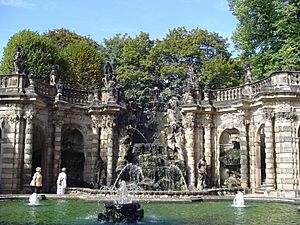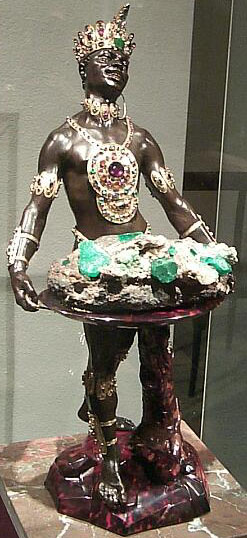Balthasar Permoser facts for kids
Balthasar Permoser (born August 13, 1651 – died February 18, 1732) was a very important sculptor of his time. His art style changed from the grand Baroque period to the lighter, more playful early Rococo period.
Contents
Early Life and Training
Balthasar Permoser was born in Kammer bei Waging, which is now part of Traunstein, Germany. He first learned sculpture in Salzburg with Wolf Weißenkirchner the Younger. Later, in Vienna, he learned how to carve ivory.
In 1675, Permoser traveled to Florence, Italy. He worked for Giovanni Battista Foggini for 14 years. This time helped him develop his unique artistic style.
Working for Royalty
In 1689, John George III, Elector of Saxony invited Permoser to Dresden. There, Permoser created two large garden statues of the hero Hercules.
In 1697, he visited Salzburg again. He sculpted strong figures, called atlantes, for the west entrance of the Hofstallung building. From 1704 to 1710, he worked at the Schloß Charlottenburg near Berlin.
The Zwinger Palace
Permoser returned to Dresden to work on the famous Zwinger palace. He worked with the architect Matthäus Daniel Pöppelmann. The Zwinger was built between 1710 and 1728 for Augustus the Strong, who was the Elector of Saxony.
Permoser created many detailed sculptures for the Zwinger. For the Wallpavillon part of the palace, he made six of the twelve famous, strong, and expressive atlantes. He also created the sculptures for the beautiful Nymphenbad fountain at the Zwinger.
Famous Sculptures
One of Permoser's most famous standalone sculptures is a large marble statue called Apotheosis of Prince Eugene. He made it between 1718 and 1721. This statue shows Prince Eugene of Savoy as a hero, like Hercules. It also includes figures of Fame and a defeated Turk. This complex statue is now in the Österreichische Galerie Belvedere in Vienna.
Permoser also made two wooden figures of Saint Augustine and Saint Ambrose. These were for the main altar of the Dresden Hofkirche in 1725. They are now in the Stadtmuseum, Bautzen. He also carved a special pulpit for Augustus's chapel. This pulpit was later moved to the Hofkirche. Permoser also created sculptures for the tomb of Sophie of Saxony and Wilhelmine Ernestine of the Palatine in the Freiberg Cathedral.
Collaborations and Influence
Permoser often worked with Johann Melchior Dinglinger, who was a court jeweler to Augustus. A great example of their teamwork is two sculptures of Moors by Permoser. Dinglinger then added beautiful jewels to these sculptures. You can see them in the Neues Grünes Gewölbe in Dresden.
Permoser also made models for the Meissen factory. This factory was owned by Augustus. Permoser's models were used to create figures from the commedia dell'arte (a type of Italian comedy). These figures, made around 1710-1712, were early examples of the famous porcelain figurines that became popular all over Europe.
His personal works included portrait busts and small Rococo sculptures made of colored wood or ivory. He also created special containers for holy objects (reliquaries) and emotional pieces for personal prayer. Permoser's student, Paul Egell, and Egell's student, Johann Joachim Kändler, continued Permoser's artistic style into the mid-1700s.
Permoser died in Dresden in 1732.
Images for kids
See also
 In Spanish: Balthasar Permoser para niños
In Spanish: Balthasar Permoser para niños





